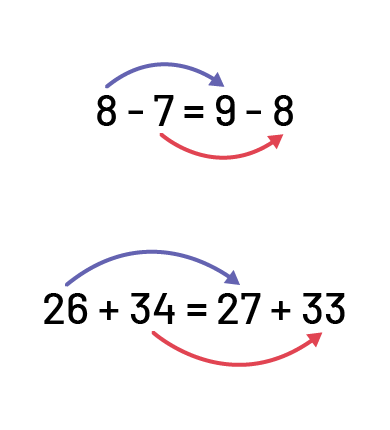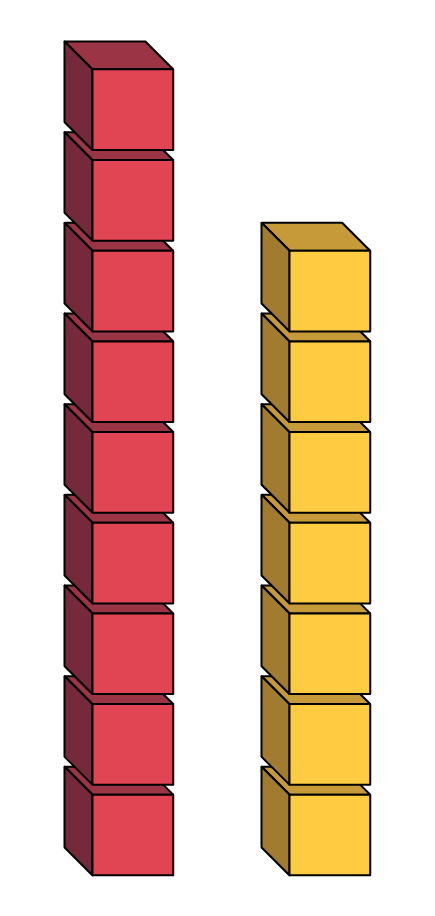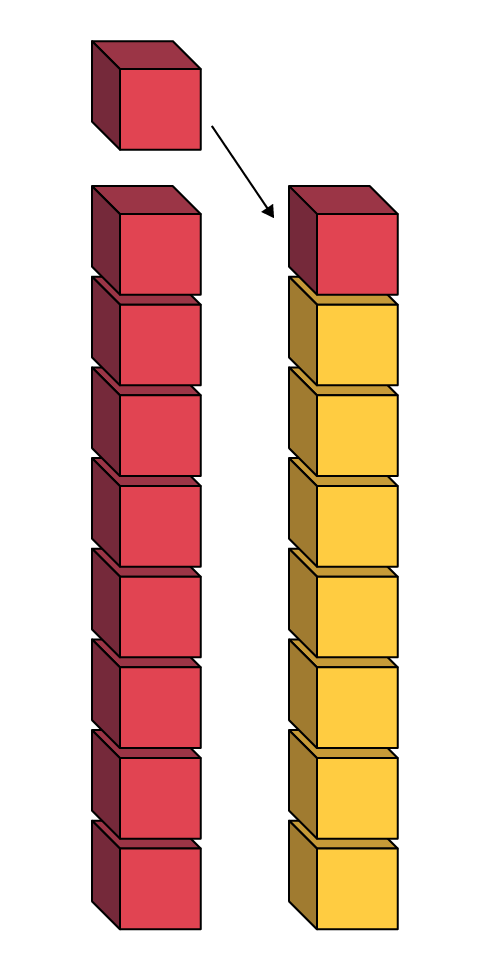C2.2 Determine whether given sets of addition, subtraction, multiplication, and division expressions are equivalent or not.
Skill: Determining Whether or not Sets of Expressions Involving the Four Operations are Equivalent
Two sets of numerical expressions are equivalent when they represent the same quantity.
For example, by representing the expressions 3 × 4 and 2 × 6 with rods, the student can visually identify that they are equivalent since they both have the same length which is representing the same quantity.

Two numeric expressions are not equivalent when they represent different quantities. In a number sentence, the equal sign with a slash through it (≠) is a symbol that represents this non-equivalence of two different quantities.
The equal sign should not be considered a symbol that announces the answer to an equation, but as a symbol that shows equality between two quantities.
Source: Ontario Curriculum, Mathematics Curriculum, Grades 1-8, 2020, Ontario Ministry of Education.
Through algebraic reasoning, students analyze numbers, symbols, quantities, operations, and then generalize them.
A significant mathematical step in the development of algebraic thinking is to understand that a situation of equality can be represented using different models.
Students may use a variety of modes of representation. Mathematical relationships can be represented using concrete or semi-concrete materials, symbols, or oral descriptions. When students represent an algebraic situation using one or both modes of representation, they use a variety of models such as tables, number grids, or number lines. These models help them organize, record, and communicate their thinking as they explore situations of equality. Representing numerical expressions using concrete, semi-concrete, or symbolic models, along with oral description, facilitates observation of relationships and contributes to the development of algebraic thinking. The different representations help students to appropriate algebraic concepts.

It is essential that students explore and represent equality relationships in a variety of ways before expressing them symbolically in a number sentence. A sentence such as 20 + 15 = 35 becomes meaningless when the focus is first on the symbols used. Before performing calculations, students need to explore numbers using models to support their reasoning. Symbol meaning is developed through the use of various representations of equal and unequal relationships. Teacher questioning, combined with manipulation of symbols and numbers using different strategies, will allow students to propose conjectures and subsequently generalize.
In algebra, students need to grasp the concept of equality and inequality in order to fully understand equivalence as a relationship between two quantities. Students must first explore these concepts with concrete materials.
When faced with a situation of equality represented by symbols, teachers should lead students to recognize the relationship between the two numerical expressions on either side of the = sign. For example, in the number sentence 18 = 6 × 3, 18 and 6 × 3 are two representations of the number 18, and the = sign is the symbol that shows the equality relationship between these representations. Understanding this relationship will enable students to more effectively manipulate the numbers, the variables in an equation.
Meaning of the Equal Sign
The equal sign is universally recognized. However, students often misinterpret the equal sign, perceiving it as a signal to perform an operation from left to right.
Subsequently when students explore the symbolic representation of an equality or equivalence situation, such as the equation 4 + 3 = □ + 2, students believe that the number 7 should be inserted into the unknown box, since it represents the answer to the operation 4 + 3, appearing to the left of the = sign. When asked to process the number 2, students add it to 7, as if the number sentence simply continued from left to right: 4 + 3 = 7 + 2. Students do not perceive the = sign as a symbol of the equality or equivalence relationship between the expressions on either side of it.
This misconception stems in part from the fact that students often see equality situations presented by simple number sentences such as 4 + 1 = 5. To address this misconception, teachers can:
- ask students if 14 + 6 is the same as 6 + 14.
Note: This type of questioning promotes a better understanding of the concepts of relationship and equality.
- present different types of number sentences to allow students to explore the concept of the = sign as a relationship.
Here are some of them:
- Sentence with only one number on either side of the = sign, e.g. 5 = 5
- Sentence encouraging the use of a strategy, for example "the strategy of comparing terms"

- Sentences that use a property, for example the commutativity property: 5 + 10 = 10 + 5;
- Sentences where one of the numerical expressions has more than two terms, for example 5 = 2 + 2 + 1 or 55 = 25 + 25 + 5;
- Sentences with different operations on each side of the = sign, e.g. 29 + 2 = 33 - 2.
The equal sign represents the relationship between the expressions and not the symbol that systematically precedes the answer to an operation.
It is important to encourage students to be explicit about their own understanding of the = sign. These exchanges will ensure that teachers can check this understanding and that students can use mathematical arguments, one of the foundations of algebraic thinking.
Source: translated from Guide d’enseignement efficace des mathématiques de la maternelle à la 3e année, Modélisation et algèbre, Fascicule 2, Situations d'égalité, p. 36-39.
Skill: Creating a Situation of Equality
To develop algebraic reasoning, it is also important that students explore situations of inequality. These situations require the use of strategies to restore equality (make it true) and require a higher level of thinking (analysis). Restoring the equality of a situation is done first with concrete materials (e.g., with towers of cubes, 10 frames, rulers, scales) and then with symbols.
Example with Concrete Material


Example Using Symbol
23 + 14 ≠ 14 + 21.

Source: translated from Guide d’enseignement efficace des mathématiques de la maternelle à la 3e année, Modélisation et algèbre, Fascicule 2, Situations d'égalité, p. 44-45.
Knowledge: Numeric Expression
An expression that contains only numbers linked together by operations. All numbers are, by definition, numeric expressions.
Examples
3 + 9 – 2
5 × 4
10
Source: translated from Guide d’enseignement efficace des mathématiques de la maternelle à la 3e année, Modélisation et algèbre, Fascicule 2, Situations d'égalité, p. 32.
Knowledge: Pairs of Equivalent Numeric Expressions
Numerical expressions are equivalent when they produce the same result.
Source: Ontario Curriculum, Mathematics Curriculum, Grades 1-8, 2020, Ontario Ministry of Education..
For example, by observing two leaps of 5 and 20 on one number line and two leaps of 20 and 5 on another number line, the student sees that the expression 5 + 20 is equivalent to 20 + 5 since the sum of the two expressions represents a quantity of 25.
